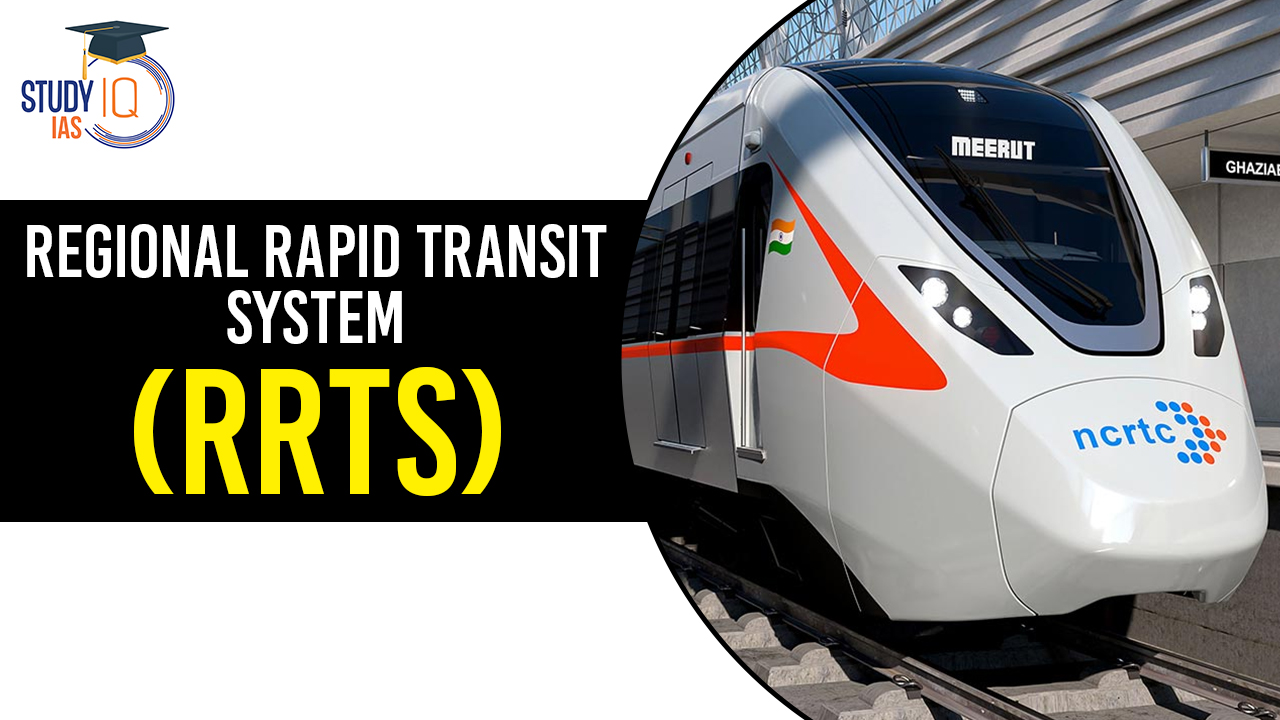Table of Contents
On October 20, 2023, Prime Minister Shri Narendra Modi is scheduled to inaugurate the Delhi-Ghaziabad-Meerut Regional Rapid Transit System (RRTS) Corridor’s priority section, marking the beginning of RRTS operations in India. Simultaneously, he will launch the inaugural RapidX train connecting Sahibabad to the Duhai Depot. The event, to be held at the Sahibabad RapidX Station in Uttar Pradesh, is a momentous occasion in India’s transportation landscape. Additionally, the Prime Minister will dedicate two segments of the Bengaluru Metro’s east-west corridor to the nation, enhancing urban transportation infrastructure in Bengaluru.
Regional Rapid Transit System (RRTS) Project
The Regional Rapid Transit System (RRTS) is an 82.15 km (51.05 mi) semi-high-speed rail network that establishes crucial connections between Delhi, Ghaziabad, and Meerut as part of Delhi’s broader Regional Rapid Transit System. Compared to the metro, RRTS offers triple the speed, significantly improving transportation efficiency. With a total of 22 stations, the initial phase stretches 17 kilometers from Sahibabad to Duhai, making stops at Sahibabad, Ghaziabad, Guldhar, Duhai, and Duhai terminals.
The RRTS is a collaborative effort, with funding derived from multilateral institutions (60%), central and state governments, including the Aam Aadmi Party (AAP)-led Delhi government. The total project cost for this corridor amounts to Rs 30,724 crore, with the UP government contributing Rs 6,500 crore. In the 2023-24 budget, the UP government has allocated Rs 1,306 crore for the Delhi-Ghaziabad-Meerut RRTS project. The RRTS aims to enhance passenger convenience, promoting the use of public transportation for a smoother travel experience.
Regional Rapid Transit System (RRTS) Launch Date
On October 20, 2023, at approximately 11:15 AM, Prime Minister Shri Narendra Modi will dedicate two segments of the east-west corridor of the Bengaluru Metro to the nation. Simultaneously, he will inaugurate the priority section of the Delhi-Ghaziabad-Meerut RRTS Corridor at the Sahibabad RapidX Station in Uttar Pradesh.
Regional Rapid Transit System Background
In 2005, the Planning Commission established a Task Force with the Secretary of the Ministry of Urban Development (MoUD) as its Chairman. The task force’s primary objective was to create a comprehensive multi-modal transit system for the Delhi National Capital Region (NCR). This initiative was integrated into the Integrated Transport Plan for NCR 2032, with a particular focus on the Regional Rapid Transit System (RRTS) designed to link regional centers.
Within this framework, the Task Force identified a total of eight corridors, with special attention given to three corridors for prioritized implementation: Delhi-Meerut, Delhi-Panipat, and Delhi-Alwar.
India’s First Regional Rapid Transit System
India’s inaugural Regional Rapid Transit System (RRTS), the Delhi–Meerut RRTS, spans 51.05 miles, linking Delhi, Ghaziabad, and Meerut. This high-speed system boasts a design speed of 180 kmph, ensuring swift and efficient travel. The RRTS is set to revolutionize intercity commuting, offering a secure and modern transportation solution. Moreover, it prioritizes seamless multi-modal integration, connecting seamlessly with railway stations, metro networks, and bus services. The much-anticipated inauguration of the RRTS’s priority section by Prime Minister Narendra Modi is scheduled for October 20, 2023, in Uttar Pradesh.
Delhi–Meerut Regional Rapid Transit System
India’s inaugural semi-high-speed rail line, the Delhi–Meerut Regional Rapid Transit System (RRTS), is presently in the construction phase. This transformative system will establish vital connections between Delhi, Ghaziabad, and Meerut, covering a substantial 82.15 km distance and featuring 22 stations. With a design speed of 180 km/h and an average operating speed of 100 km/h, the RRTS promises efficient intercity commuting.
The RRTS’s initial phase, spanning 17 km, will commence at Sarai Kale Khan in Delhi and culminate at Modipuram in Meerut, incorporating five key stations: Sahibabad, Ghaziabad, Guldhar, Duhai, and Duhai Depot. To ensure seamless travel, the RRTS will employ a combination of tunnels and elevated viaducts. Each train will consist of six coaches, including a premium coach equipped with distinct entry and exit points. Notably, the RRTS distinguishes itself from the traditional Metro rail system. The Sahibabad to Meerut South section is anticipated to commence operations in March 2023.
Difference Between RRTS and Metro
| Aspect | RRTS | Metro |
| Purpose | Long-distance, fast, comfortable travel | Local, connecting areas in the city |
| Speed | Up to 100 km in 60 minutes | Designed speed of 90 km/hr, operational speed of 80 km/hr |
| Features | Luggage carriers, mini screens | Typically fewer additional features |
| Pathway | Dedicated pathway for regional travel | Operates on independent rail lines |
| Proposed Travel Times | Delhi–Panipat: 1 hour, Delhi–Meerut: 1 hour, Delhi–Alwar: 2 hours | N/A |
Significance of Regional Rapid Transit System (RRTS)
Environmentally Friendly
The corridor is projected to reduce annual greenhouse gas emissions by 250,000 tonnes, significantly enhancing the city’s environmental quality and overall livability.
Economic Advancement
The corridor is expected to boost public transportation usage along its route, increasing the share from 37% to 63%. This increased connectivity will lead to a more balanced economic development across the region, ensuring that economic benefits reach all segments of society and various development hubs, rather than concentrating all economic activity in one area.
Promoting Sustainable Urbanization
This project will serve as a model for creating high-capacity rapid urban transit corridors in other Indian urban centers. It will play a crucial role in alleviating traffic congestion and reducing emissions from the transportation sector in the National Capital Region (NCR).
Regional Rapid Transit System UPSC
On October 20, 2023, Prime Minister Narendra Modi is set to inaugurate the Delhi-Ghaziabad-Meerut Regional Rapid Transit System (RRTS) Corridor, heralding a new era of high-speed intercity travel in India. The RRTS, covering 82.15 kilometres and offering travel speeds of up to 100 km per hour, is designed for long-distance, comfortable commuting. It distinguishes itself from the metro by connecting regional centres and providing features like luggage carriers and mini-screens. This initiative, funded by various sources, aims to reduce emissions and promote public transport usage, fostering economic development and sustainable urbanization. It will also serve as a model for similar projects in India.


 Nuclear Non-Proliferation Treaty (NPT), ...
Nuclear Non-Proliferation Treaty (NPT), ...
 Polar Satellite Launch Vehicle (PSLV), V...
Polar Satellite Launch Vehicle (PSLV), V...
 India's Aircraft Carrier List, Name, His...
India's Aircraft Carrier List, Name, His...





















